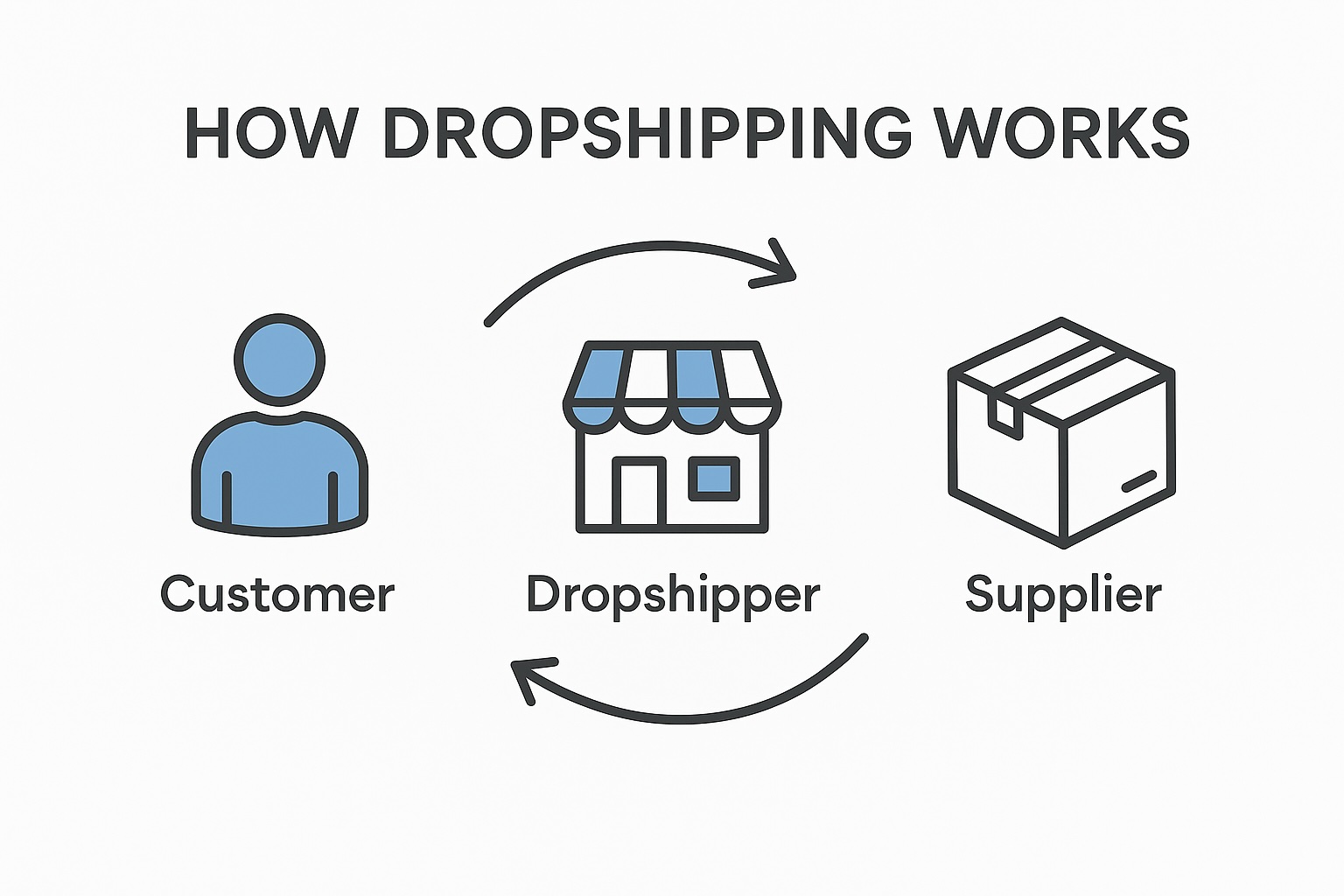tarting a business can feel overwhelming, especially when you're completely new to ecommerce. We get it – there's so much information out there about dropshipping for beginners that it's hard to know where to even start. Should you pick products first? Build a website? Find suppliers? The confusion stops here.
Dropshipping for beginners doesn't have to be complicated. We've helped thousands of people launch their first stores, and we've learned that success comes from following a clear, simple process. You don't need to be a tech expert, marketing genius, or have thousands of dollars to invest.
In this comprehensive guide, we're breaking down dropshipping for beginners into 10 straightforward steps. By the end of this article, you'll know exactly what to do, in what order, and how to avoid the most common mistakes that trip up new dropshippers. No confusing jargon, no overwhelming technical details – just practical advice that actually works.
Let's demystify the process and get you started on your dropshipping journey today.
What Is Dropshipping? (The Simple Explanation)
Before we dive into our dropshipping for beginners guide, let's make sure we're all on the same page about what dropshipping actually is.
Here's the simple version:

Dropshipping is a business model where you sell products online without ever holding inventory. When a customer buys from your store, you forward the order to your supplier, who ships the product directly to your customer. You keep the difference between what the customer paid and what you paid the supplier.
A real example:
- Customer sees a coffee mug on your store for $25
- Customer buys the mug from you
- You forward the order to your supplier and pay them $12
- Supplier ships the mug directly to your customer
- You keep $13 profit (minus any platform fees and advertising costs)
Why dropshipping for beginners is perfect:
- No inventory to buy upfront
- No warehouse or storage space needed
- No packing or shipping products yourself
- Low startup costs (often under $500)
- Work from anywhere with an internet connection
- Test products without financial risk
According to Shopify's research on dropshipping, the global dropshipping market is expected to reach $476 billion by 2026, making it an increasingly viable business model for beginners.
Step 1: Choose Your Niche
The first step in dropshipping for beginners is choosing what you want to sell. This is called your "niche" – basically, the specific category or type of products you'll focus on.
Why niches matter:
Instead of selling everything to everyone (which rarely works), successful dropshippers focus on specific markets. For example, instead of "pet products," you might focus on "eco-friendly dog toys" or "cat furniture for small apartments."
How to choose your niche:
- Consider your interests: You'll spend lots of time working with these products. Choose something you find at least somewhat interesting.
- Research demand: Use Google Trends to see if people are actually searching for products in your niche. Look for steady or growing interest, not declining trends.
- Check competition: Some competition is good (proves people buy these products), but avoid overcrowded markets like phone cases or generic fashion.
- Evaluate profit potential: Can you sell products for at least 2-3x what you pay? You need healthy margins to cover advertising and platform costs.
- Think long-term: Choose a niche with potential for repeat customers or expanding into related products as you grow.
Good niches for dropshipping for beginners:
- Home organization products
- Pet accessories for specific animals
- Fitness equipment for home workouts
- Sustainable/eco-friendly products
- Hobby-specific supplies (knitting, gaming, gardening)
For more insights on niche selection, check out our guide on micro niche dropshipping.
Step 2: Research and Validate Your Product Ideas
Once you've chosen your niche, the next step in dropshipping for beginners is finding specific products to sell. Don't just guess – validate your ideas with research.
Where to find product ideas:
- Amazon bestsellers: Browse Amazon's bestseller lists in your niche. These are proven sellers with real customer demand.
- Social media trending: Check TikTok, Instagram, and Facebook for trending products. What are influencers promoting? What's going viral?
- Problem-solving: Think about common problems in your niche. Products that solve real problems tend to sell well.
- Seasonal opportunities: Consider holidays, seasons, and events that create demand for specific products.
- Competitor stores: Look at successful dropshipping stores in your niche. What products do they feature prominently?
Validation checklist:
✅ Search volume: Are people actually searching for this product?
✅ Competition level: Can you realistically compete with existing sellers?
✅ Profit margin: Can you make at least $10-15 profit per sale?
✅ Shipping feasibility: Can it be shipped safely and affordably?
✅ Supplier availability: Can you find reliable suppliers for this product?
✅ Return potential: Is this something that's unlikely to have high return rates?
Red flags to avoid:
❌ Extremely cheap items (under $10 retail) - hard to profit after fees
❌ Fragile or easily damaged products - high return rates
❌ Oversaturated products everyone is selling
❌ Branded items that could violate trademarks
❌ Products with complex sizing (clothing can be tricky for beginners)
Learn more about product validation in our comprehensive guide on finding winning dropshipping products.
Step 3: Find Reliable Suppliers
Finding good suppliers is crucial for dropshipping for beginners. Your supplier determines product quality, shipping times, and customer satisfaction.
Where to find suppliers:
- DropCommerce: Our top recommendation for beginners. Focuses on North American suppliers with quality products and fast shipping times. Browse products for free, subscribe to import to your store.
- AliExpress: Massive selection and very cheap prices, but shipping from China can take weeks. Good for testing, challenging for customer satisfaction.
- Spocket: Focuses on US and European suppliers with faster shipping than AliExpress.
- Printful/Printify: Excellent for custom print-on-demand products like t-shirts, mugs, and phone cases.
What to look for in suppliers:
- Shipping times: Faster is better. Customers expect products within 1-2 weeks maximum. DropCommerce's North American suppliers typically deliver in 3-7 days.
- Product quality: Order samples before selling. Never sell products you haven't personally evaluated.
- Communication: Good suppliers respond quickly to questions and resolve issues professionally.
- Pricing: Ensure you can mark up products enough to cover costs and make profit.
- Return policies: Understand the supplier's return and refund policies. This affects how you handle customer issues.
- Reliability: Check reviews and ratings. Consistent, reliable suppliers are worth their weight in gold.
Pro tip for dropshipping for beginners: Start with 5-10 products from one supplier. Master working with one reliable partner before adding complexity.
Step 4: Set Up Your Online Store
Now we get to the exciting part of dropshipping for beginners – building your store! This is easier than you might think.
Choose your platform:
Shopify (Recommended): The easiest platform for dropshipping for beginners. Currently offers 3-day free trial plus 3 months for $1/month.
Why we recommend Shopify:
- Designed specifically for ecommerce
- Easy to use, even with no technical skills
- Integrates seamlessly with DropCommerce and other suppliers
- Professional templates included
- Handles payments, taxes, and shipping calculations
- 24/7 support when you need help
Setting up your store:
Choose a store name: Keep it simple, memorable, and related to your niche. Check that the .com domain is available.
Select a template: Shopify offers free professional templates. Choose one that fits your product type and looks professional.
Add essential pages:
- Homepage: Showcase your best products
- Product pages: Clear photos, detailed descriptions
- About page: Build trust by sharing your story
- Contact page: Make it easy for customers to reach you
- Shipping policy: Set clear expectations
- Return policy: Follow industry standards
- Privacy policy: Required for legal compliance
Set up payment processing: Shopify Payments is easiest. Also add PayPal as an alternative option.
Configure shipping: Set up shipping zones and rates. Be transparent about costs and delivery times.
Design tips for dropshipping for beginners:
- Keep it clean and simple
- Use high-quality product photos
- Make navigation easy and intuitive
- Ensure mobile-friendliness (most traffic is mobile)
- Include trust badges and security icons
- Add customer reviews when you get them
Time investment: You can build a basic store in one weekend. Don't aim for perfection – launch and improve over time.
Step 5: Import Products and Write Descriptions

With your store set up, it's time to add products. This step in dropshipping for beginners is where your store starts to feel real.
Importing products from DropCommerce:
Browse the catalog: Explore products in your niche. Filter by category, price, and supplier.
Select your products: Start with 5-10 products. You can always add more later.
Import to Shopify: With DropCommerce's integration, products import with one click, including photos and basic descriptions.
Writing product descriptions:
Don't just use the supplier's description. Make yours unique and compelling.
Good product description formula:
- Headline benefit (solve a problem or desire)
- Key features in bullet points
- Detailed explanation of benefits
- Technical specifications
- Social proof (if available)
- Clear call-to-action
Description tips for dropshipping for beginners:
Focus on benefits, not features: Instead of "made of stainless steel," say "lasts for years without rusting."
Use emotional language: Connect with how customers will feel using your product.
Answer common questions: Address size, materials, care instructions, and usage.
Be honest: Don't overpromise. Accurate descriptions reduce returns and negative reviews.
Use AI assistance: Tools like ChatGPT can help write compelling descriptions. Just review and personalize them.
Optimize for SEO: Include relevant keywords naturally in your titles and descriptions.
For more on using AI for content creation, read our guide on AI tools for dropshipping.
Step 6: Set Your Prices
Pricing is critical in dropshipping for beginners. Price too high and nobody buys. Price too low and you can't afford to advertise or make profit.
Simple pricing formula:
Retail Price = (Product Cost + Shipping Cost) × 2.5 to 3
Example:
- Product from supplier: $15
- Shipping cost: $5
- Total cost: $20
- Your retail price: $50-60
This gives you roughly 60-70% profit margin before advertising costs.
Pricing considerations:
Check competitors: What are similar products selling for? Stay within the expected range.
Consider advertising costs: You'll typically spend 20-40% of revenue on ads. Your margins need to support this.
Perceived value: Higher prices can increase perceived quality. Don't race to the bottom.
Psychological pricing: $19.99 performs better than $20.00 in most cases.
Shipping costs: Consider offering "free shipping" with prices adjusted to include shipping costs.
Pricing strategy for dropshipping for beginners:
Start with healthy margins (2.5-3x markup). It's easier to lower prices than raise them later. Monitor your profit margins on each sale and adjust as you learn what works.
Step 7: Create Your Marketing Plan

Your store is ready, but customers won't magically appear. This step in dropshipping for beginners is where you drive traffic to your store.
Organic marketing (free but time-intensive):
Social media marketing:
- Create Instagram and TikTok accounts for your store
- Post product photos, demonstrations, and lifestyle content
- Use relevant hashtags to reach your target audience
- Engage with potential customers by commenting and messaging
- Post consistently (3-5 times per week minimum)
Content marketing:
- Start a blog on your Shopify store
- Write helpful articles related to your products
- Optimize for Google search (SEO)
- Share your content on social media
Email marketing:
- Collect email addresses with pop-ups and offers
- Send regular newsletters with new products and promotions
- Recover abandoned carts with automated emails
Paid marketing (faster results but requires budget):
Facebook and Instagram ads:
- Start with $10-20 per day testing budget
- Target specific demographics and interests
- Test different ad creative and copy
- Focus on video ads when possible
TikTok ads:
- Minimum $20/day budget
- Great for reaching younger audiences
- Make ads that don't look like ads (native content)
Google Shopping:
- Good for products with clear search intent
- Can be more expensive but higher quality traffic
Marketing tips for dropshipping for beginners:
Start with one channel: Master Facebook ads OR TikTok organic before trying everything at once.
Create quality content: Invest time in good photos and videos of your products.
Test and learn: Track what works and do more of it. Stop what doesn't work.
Build trust: Share customer testimonials, reviews, and user-generated content.
Be patient: Marketing takes time to learn. Expect a learning curve of 1-3 months.
Step 8: Launch and Make Your First Sales
You've done the preparation – now it's time for the most exciting step in dropshipping for beginners: launching your store and getting your first sales!
Pre-launch checklist:
✅ All product pages complete with descriptions and images
✅ Shipping and return policies clearly stated
✅ Payment processing tested and working
✅ Mobile experience checked and optimized
✅ Social media accounts created and linked
✅ Analytics set up (Google Analytics, Facebook Pixel)
✅ Email collection pop-up configured
✅ First batch of content ready to post
Launching strategies:
Soft launch: Start by telling friends and family. Get their feedback and your first reviews.
Grand opening promotion: Offer a special discount (10-20% off) for your first week to generate excitement.
Social media blitz: Post daily leading up to and during your launch week.
Influencer outreach: Contact micro-influencers in your niche and offer free products for reviews.
Getting your first sale:
Your first sale usually comes from:
- Friends and family (perfectly fine!)
- Organic social media followers
- Small advertising tests
- Community engagement (Reddit, Facebook groups)
What to do after your first sale:
🎉 Celebrate! Your first sale proves your concept works.
📧 Send a thank-you email to your customer
📦 Process the order immediately with your supplier
📱 Follow up after delivery to request a review
📊 Analyze what marketing led to the sale
Realistic expectations for dropshipping for beginners:
- First sale: Usually within 1-4 weeks
- Consistent sales: 1-3 months with regular effort
- Profitable: 2-4 months after optimizing ads and operations
- Full-time income potential: 6-12 months with dedication
Step 9: Process Orders and Handle Customer Service
Once sales start coming in, dropshipping for beginners requires managing orders and keeping customers happy.
Order processing workflow:
- Customer places order: You receive notification via email and in your Shopify dashboard.
- Forward to supplier: With DropCommerce integration, this often happens automatically. Otherwise, manually place the order with your supplier.
- Provide tracking information: Once shipped, add tracking number to the customer's order in Shopify. They'll receive automatic updates.
- Monitor delivery: Keep an eye on orders to catch any issues early.
Customer service essentials:
- Respond quickly: Reply to questions within 24 hours maximum. Faster is better.
- Be proactive: If there's a shipping delay, contact customers before they contact you.
- Handle issues professionally: Mistakes happen. Apologize, solve the problem, and move on.
- Know your policies: Understand your return and refund policies and apply them consistently.
Common customer service scenarios:
- "Where is my order?" Check tracking, provide update, reassure customer.
- "This isn't what I expected." Apologize, offer return or partial refund.
- "It arrived damaged." Request photos, arrange return, send replacement or refund.
- "Can I change my order?" If not yet shipped, accommodate. If shipped, explain it's too late.
Customer service tips for dropshipping for beginners:
- Most customers are reasonable and understanding
- Clear communication solves most problems
- A small percentage of orders will have issues – this is normal
- Good service turns problems into positive reviews
- Build templates for common responses to save time
Step 10: Analyze, Learn, and Improve

The final step in dropshipping for beginners isn't really a final step – it's an ongoing process of improvement.
Key metrics to track:
- Traffic: How many people visit your store? Where do they come from?
- Conversion rate: What percentage of visitors buy? Industry average is 1-3%.
- Average order value: How much does the average customer spend?
- Customer acquisition cost: How much do you spend to get each customer?
- Return rate: What percentage of orders are returned?
- Profit margin: After all costs, what profit do you actually make?
What to analyze:
- Product performance: Which products sell best? Focus on winners.
- Marketing channels: Which ads or social posts drive sales? Do more of what works.
- Customer feedback: What do reviews and messages tell you? Improve based on feedback.
- Abandoned carts: Why do people add to cart but not buy? Test reducing friction.
Improvements to make:
- Month 1-2: Fix obvious problems, improve product photos and descriptions
- Month 3-4: Optimize best-performing ads, remove poor-selling products
- Month 5-6: Scale successful campaigns, expand product line, improve processes
- Ongoing: Test new products, try new marketing channels, optimize conversions
Learning resources for dropshipping for beginners:
- Shopify blog and YouTube channel
- Dropshipping communities on Reddit and Facebook
- YouTube tutorials on Facebook ads and social media marketing
- DropCommerce blog for ongoing tips and strategies
For more ways to build your business knowledge, explore our collection of weekend business ideas.
Common Beginner Mistakes to Avoid
We've seen thousands of people go through dropshipping for beginners, and certain mistakes come up repeatedly:
Trying to be perfect: Launch with "good enough" and improve over time. Perfect is the enemy of done.
Choosing too many products: Start with 5-10 products, not 100. Focus is better than overwhelming choice.
Ignoring customer service: Bad service kills businesses. Respond quickly and solve problems professionally.
Giving up too soon: Most successful dropshippers struggled for 3-6 months before finding their groove.
Not tracking numbers: You can't improve what you don't measure. Use analytics from day one.
Copying competitors exactly: Be inspired by successful stores, but create your own unique brand.
Neglecting mobile experience: Over 70% of traffic is mobile. Test everything on your phone.
Skipping product samples: Always order and test products before selling them to customers.
Alternative Paths for Beginners
While this guide covers starting from scratch, dropshipping for beginners has other options:
Buy a prebuilt store: DropCommerce and other platforms offer ready-made stores with products already selected and imported. This saves setup time and gets you to marketing faster.
Purchase an established business: If you have more capital, buying a dropshipping business with proven sales can skip the startup phase entirely. Learn more in our guide on buying an established dropshipping business.
Join a partnership: Team up with someone who has complementary skills. One person handles marketing, the other handles operations.
How DropCommerce Helps Beginners Succeed
Throughout this dropshipping for beginners guide, we've mentioned DropCommerce multiple times. Here's why we're ideal for beginners:
- Quality North American suppliers: Fast shipping (3-7 days typically) and reliable quality help you build customer trust.
- Easy Shopify integration: One-click product imports save hours of manual work.
- Curated product selection: We've pre-vetted suppliers and products, reducing your research time.
- No inventory risk: Browse products for free, only subscribe when you're ready to start importing.
- Growing with you: Start with our Growth plan ($55/month) and scale as your business grows.
- Support and resources: Access guides, tutorials, and support to help you succeed.
Many successful dropshippers started with DropCommerce because it simplified the supplier relationship and let them focus on marketing and growing their business.
Your Dropshipping Journey Starts Now

You now have a complete roadmap for dropshipping for beginners. Let's recap the 10 essential steps:
- Choose your niche - Focus on a specific market you can serve well
- Research products - Validate demand before committing
- Find suppliers - Partner with reliable suppliers like DropCommerce
- Set up your store - Build on Shopify using professional templates
- Import products - Add 5-10 products with compelling descriptions
- Set prices - Use 2.5-3x markup for healthy margins
- Create marketing plan - Choose one channel and master it
- Launch your store - Go live and get your first sales
- Handle operations - Process orders and provide great service
- Analyze and improve - Track metrics and optimize continuously
Realistic timeline for dropshipping for beginners:
- Week 1: Choose niche and research products
- Week 2: Find suppliers and set up store
- Week 3: Import products and launch
- Week 4-8: Learn marketing and get first sales
- Month 3-6: Optimize and grow toward profitability
Final advice:
Don't wait for perfect conditions. Start with what you have and learn as you go. Every successful dropshipper was once a complete beginner who took the first step.
The hardest part is starting. The second hardest part is not giving up when it gets challenging. Push through the learning curve, and you'll develop skills that can generate income for years to come.
Dropshipping for beginners is absolutely achievable. You don't need special skills, a business degree, or massive capital. You need curiosity, persistence, and willingness to learn from mistakes.
Your journey starts with step one: choosing your niche. What will yours be?












